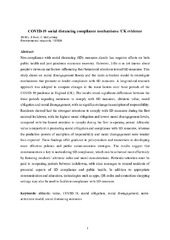| dc.contributor.author | Wu, Jialin (Snow) | |
| dc.contributor.author | Font aulet, Xavier | |
| dc.contributor.author | McCalmley, Claire | |
| dc.date.accessioned | 2022-02-01T09:20:44Z | |
| dc.date.available | 2022-02-01T09:20:44Z | |
| dc.date.issued | 2021-12-23 | |
| dc.description.abstract | Non-compliance with social distancing (SD) measures clearly has negative effects on both public health and post-pandemic economic recovery. However, little is as yet known about people's views on and factors influencing their behavioral intentions toward SD measures. This study draws on moral disengagement theory and the norm-activation model to investigate mechanisms that promote or hinder compliance with SD measures. A longitudinal research approach was adopted to compare changes in the main factors over three periods of the COVID-19 pandemic in England (UK). The results reveal significant differences between the three periods regarding intentions to comply with SD measures, altruistic value, moral obligation and moral disengagement, with no significant change in ascription of responsibility. Residents showed the strongest intentions to comply with SD measures during the first national lockdown, with the highest moral obligation and lowest moral disengagement levels, compared with the lowest intention to comply during the first re-opening period. Altruistic value is important in promoting moral obligation and compliance with SD measures, whereas the predictive powers of ascription of responsibility and moral disengagement were weaker than expected. These findings offer guidance to policymakers and researchers in developing more effective policies and public communication strategies. The results suggest that communication is key to normalizing SD compliance, which can be achieved most effectively by fostering residents' altruistic value and moral considerations. Particular attention must be paid to re-opening periods between lockdowns, with clear messages to remind residents of prosocial aspects of SD compliance and public health. In addition to appropriate communication and education, technologies such as apps, QR codes and contactless shopping settings may also be used to facilitate compliance with SD measures. | en_US |
| dc.description | Accepted manuscript version, licensed <a href=http://creativecommons.org/licenses/by-nc-nd/4.0/> CC BY-NC-ND 4.0. </a> | en_US |
| dc.identifier.citation | Wu, Font aulet, McCalmley. COVID-19 social distancing compliance mechanisms: UK evidence. Environmental Research. 2021;205 | en_US |
| dc.identifier.cristinID | FRIDAID 1988835 | |
| dc.identifier.doi | 10.1016/j.envres.2021.112528 | |
| dc.identifier.issn | 0013-9351 | |
| dc.identifier.issn | 1096-0953 | |
| dc.identifier.uri | https://hdl.handle.net/10037/23865 | |
| dc.language.iso | eng | en_US |
| dc.publisher | Elsevier | en_US |
| dc.relation.journal | Environmental Research | |
| dc.rights.accessRights | openAccess | en_US |
| dc.rights.holder | Copyright 2021 The Author(s) | en_US |
| dc.title | COVID-19 social distancing compliance mechanisms: UK evidence | en_US |
| dc.type.version | acceptedVersion | en_US |
| dc.type | Journal article | en_US |
| dc.type | Tidsskriftartikkel | en_US |
| dc.type | Peer reviewed | en_US |


 English
English norsk
norsk